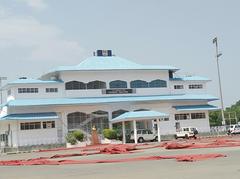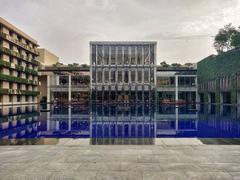Indian National Defence University Visiting Hours, Tickets, and Guide to Gurgaon Historical Sites
Date: 04/07/2025
Introduction to the Indian National Defence University and Its Significance
The Indian Defence University (IDU), located near Gurugram in Haryana, stands as a transformative institution in the field of defence education, research, and strategic studies in India. Established as a unified platform for the country’s premier defence academic institutions, IDU seeks to bridge the divide between military education, strategic research, and policy formulation, responding to the evolving security needs of the 21st century. The vision for a national defence university originated in 1967 and gained fresh momentum after the 1999 Kargil War, underscoring the necessity for an integrated academic framework to bolster national security (cenjows.in; wikipedia).
Although the foundation stone for its permanent campus was laid in 2013 by then Prime Minister Dr. Manmohan Singh at Binola near Gurugram, the university currently operates from a temporary campus while full infrastructure is under development (gktoday.in). IDU’s institutional structure affiliates distinguished establishments such as the National Defence Academy (NDA), National Defence College (NDC), and Defence Services Staff College (DSSC), fostering synergy between military and civilian scholars (military-history.fandom.com).
This comprehensive guide outlines the historical evolution, strategic significance, and practical visitor information for those interested in exploring the Indian Defence University. It also highlights campus facilities, visitor protocols, nearby attractions, and travel tips essential for planning your visit—whether you are a scholar, professional, or enthusiast of military education.
Table of Contents
- Introduction
- Historical Background and Evolution
- Rationale and Strategic Significance
- Institutional Structure and Affiliations
- Visitor Information
- Visitor Experience and Practical Tips
- Access, Security, and Protocols
- Campus Layout, Facilities, and Tours
- Photography and Events
- Dress Code and Etiquette
- Transportation and Parking
- Health, Safety, and Emergencies
- Cultural Sensitivity and Language
- Accessibility for International Visitors
- Accommodation and Dining
- Responsible Conduct and Legal Considerations
- Environmental Awareness
- Additional Tips
- FAQ
- References and Resources
- Conclusion
Historical Background and Evolution
Early Conception and Initial Proposals (1967–1980)
The idea of a dedicated national defence university for India was first mooted in 1967, driven by the recognition that robust academic research was essential for effective policy-making in defence. The Sethna Committee, in 1980, formally recommended the creation of a national defence university to bridge the gap between academic research and government policy (cenjows.in; wikipedia).
Post-Kargil War Momentum and Policy Recommendations (1999–2001)
In the aftermath of the 1999 Kargil War, the Kargil Review Committee and Group of Ministers (GoM) reaffirmed the urgent need for a unified defence university to enhance strategic research and policy formulation (cenjows.in; wikipedia).
Cabinet Approval and Foundation Stone (2010–2013)
The Union Cabinet approved the IDU project in 2010. The foundation stone was laid at Binola, near Gurugram, on 23 May 2013 by Dr. Manmohan Singh, leveraging its proximity to Delhi and key defence establishments (wikipedia; gktoday.in).
Legislative and Administrative Delays (2013–2025)
Despite initial progress, the Indian National Defence University Act is still pending as of July 2025. Only basic infrastructure at the Binola campus has been completed, with full-scale academic operations continuing from a temporary campus. The university was renamed Indian Defence University (IDU) in December 2017 (wikipedia; cenjows.in).
Rationale and Strategic Significance
IDU is designed to centralize and standardize defence education and research in India. By affiliating premier institutions like NDA, NDC, and DSSC, it aims to overcome fragmentation and foster effective collaboration between academia and policymakers (cenjows.in).
Institutional Structure and Affiliations
IDU will function as an autonomous university, established by an Act of Parliament. The President of India serves as Visitor, with the Defence Minister as Chancellor. Led by a three-star General as President and a civilian Vice-President, the faculty comprises an equal blend of military and civilian educators. Its constituent units include NDC, DSSC, NDA, and a proposed National Defence Open University (military-history.fandom.com).
Visitor Information
Location and Accessibility
The permanent campus is at Binola, near Gurugram, on the Delhi–Jaipur Expressway (NH 48), about 26 km from Gurugram’s central business district and 43 km from Indira Gandhi International Airport. A dedicated bus bay on NH 48 is planned for future visitor access.
Visiting Hours
As the permanent campus remains under construction, public visits are restricted. Arrangements for visits must be made in advance via the Ministry of Defence or directly with the university administration.
Tickets and Entry
IDU does not have a public ticketing system. Visits are limited to official events, academic delegations, and invited guests. Prospective visitors should contact the university for permissions or guided educational visits.
Nearby Attractions
Visitors to IDU can explore a variety of historical and cultural sites in Gurugram and Delhi, such as:
- Sultanpur National Park
- Qutub Minar
- India Gate
- National Museum, New Delhi
Travel Tips
- Access the campus via NH 48 for convenience.
- The best visiting period is October to March.
- Always arrange your visit well in advance due to strict security protocols.
Qutub Minar, Delhi: A Complete Visitor’s Guide
Introduction:
Qutub Minar, a UNESCO World Heritage Site, is one of Delhi’s most iconic monuments. Built in 1193 by Qutb-ud-din Aibak, it stands 73 meters tall and features exquisite Indo-Islamic architecture. The site is renowned for its intricate carvings, Arabic inscriptions, and its role in marking the advent of Muslim rule in India.
Visiting Hours:
- Daily: 7:00 AM – 5:00 PM (last entry 30 minutes before closing)
Ticket Information:
- Indian Nationals: ₹40
- Foreign Nationals: ₹600
- Children under 15: Free
- Tickets available at the gate or online via the Archaeological Survey of India (ASI)
How to Reach:
- Metro: Qutub Minar Metro Station (Yellow Line), 1 km away
- Bus: Multiple DTC buses connect the site
- Taxi/Auto: Widely available from all over Delhi
Accessibility:
Wheelchair accessible at entry; the minaret’s interior is not open to visitors.
Nearby Attractions:
- Mehrauli Archaeological Park
- Lotus Temple (7 km away)
- Humayun’s Tomb (15 km away)
Visitor Tips:
- Arrive early to avoid crowds and heat.
- Carry water and wear comfortable shoes.
- Photography is permitted (drones/tripods need permission).
- Guided tours available.
FAQs:
- Is climbing the Qutub Minar allowed? No, for safety reasons.
- Are there entry restrictions? Security checks are mandatory; large bags and food are not allowed.
- Is nighttime access allowed? The monument is open daytime only.
- Is photography permitted? Yes, except for commercial purposes without permission.
Additional Resources:
INDU Visitor Experience and Practical Tips
Access, Visiting Hours, and Security Protocols
As a strategic facility, INDU tightly regulates visitor access. Entry is generally limited to official delegations, academic researchers, and registered event participants. General public visits and walk-ins are not allowed.
Visiting Hours:
- Weekdays: 9:00 AM – 5:00 PM
- Closed on national holidays and during special defence events
- All visits require prior authorization
Security:
- Strict ID and baggage checks
- Vehicle inspections possible
- Photography and videography are strictly prohibited (Lonely Planet)
Campus Layout, Facilities, and Guided Tours
The INDU campus in Manesar covers several acres, featuring modern lecture halls, research centers, a central library, seminar halls, and residential quarters. Key facilities include:
- Academic Blocks with advanced AV and secure communications
- Central Library with extensive defence and strategy resources
- Auditoriums for seminars and conferences
- Residential Facilities for staff, students, and dignitaries
- Dining/Mess with Indian and continental options
Guided tours can be arranged for official delegations, with visitor movement limited to designated areas.
Dress Code and Etiquette
- Formal/business attire required; military personnel must wear uniforms
- Modest clothing—no shorts, sleeveless tops, or flip-flops
- Stand when greeted by senior officers or faculty
- Address by proper titles/ranks
- Mobile phones on silent
- No smoking or alcohol on campus (Lonely Planet)
Transportation, Accessibility, and Parking
- Best reached via private taxi or arranged transport; limited public transit
- Parking for authorized vehicles only
- Ride-hailing apps (Ola/Uber) can be used—ensure drivers have directions to the secure entrance
Health, Safety, and Emergency Preparedness
- On-site first-aid and medical support
- Emergency contacts: escort or security staff
- Be aware of monsoon season (June–September) and potential flooding (Indian Meteorological Department)
Cultural Sensitivity and Language
- English is the primary language; Hindi and regional languages also common
- Greet hosts with “Namaste” or a formal handshake
- Observe hierarchy and protocol in meetings
Accessibility for International Visitors
- Valid passport/visa required; some areas may need extra clearance
- Coordinate with the university’s international office
- Currency exchange not available on campus—carry Indian Rupees
Accommodation and Dining
- Limited on-campus accommodation for official guests
- Range of hotels in Gurugram and Manesar (advance booking advised) (Holidify)
- On-campus dining restricted to authorized mess facilities; Gurgaon offers diverse dining options
Responsible Conduct and Legal Considerations
- No photography/videography; drones prohibited
- No discussion or sharing of sensitive information
- No political or religious activities
- Violations may lead to legal action (Lonely Planet)
Environmental Awareness
- Use recycling bins, avoid littering
- Campus features native flora and birdlife
Additional Practical Tips
- Carry government-issued photo ID
- Bring notebook and pen in case electronic devices are restricted
- Share dietary restrictions in advance
- Be punctual
- Familiarize yourself with local customs and regulations
Frequently Asked Questions (FAQs)
Q1: Are tickets required to visit INDU?
A1: No public ticketing. All visits require prior authorization.
Q2: Can I take photographs at INDU?
A2: No. Photography and videography are strictly prohibited.
Q3: Are guided tours available?
A3: Yes, for official delegations and researchers with advance notice.
Q4: Best way to reach INDU from Delhi Airport?
A4: Private taxi or pre-arranged vehicle.
Q5: What are some nearby tourist attractions?
A5: Sultanpur National Park, Heritage Transport Museum, Kingdom of Dreams.
Useful Links and Resources
- Official Indian National Defence University Website
- Indian Meteorological Department
- Gurgaon Tourism - Holidify
- Archaeological Survey of India - Qutub Minar
- Delhi Tourism
Conclusion
The Indian Defence University represents a pivotal development in India’s defence education and research landscape. While its permanent campus is in progress, IDU continues to play a vital role in policy-oriented research and inter-institutional collaboration. Visitor access is highly regulated for security reasons, but the campus’s modern facilities and strategic setting make it an important centre for defence scholarship. The surrounding Gurugram region offers a wealth of cultural and historical attractions, making it an enriching destination for those interested in India’s heritage and security framework.
For the latest updates, consult official sources and use digital tools like the Audiala app for curated guides and real-time information.
References
- cenjows.in
- wikipedia
- gktoday.in
- military-history.fandom.com
- http://indu.edu.in
- Lonely Planet
- Indian Meteorological Department
- Holidify
- Archaeological Survey of India - Qutub Minar
- Delhi Tourism
Explore the Indian National Defence University and Gurugram’s historical sites with confidence by planning ahead and respecting all protocols. For more, download the Audiala app and follow us on social media.

